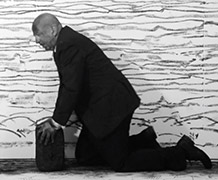
Prompted by Bideford Black, and using a shared sketchbook, artists Neville Gabie (pictured) and Joan Gabie are holding a ‘dialogue of ideas’ with Exeter Cultural Geographer Ian Cook.
Exeter geographer contributes to new exhibition of unique black pigment, Bideford Black
An exhibition at a Devon gallery provides a surprising take on a traditional material. Eleven artists and a film-maker, along with a University of Exeter researcher, have created new work using a unique black coal-like substance. Some of the works will join the gallery’s permanent collection for future generations to explore.
Valued for its silky texture and pitch black hue, Bideford Black pigment has historically been used by artists, industries and the military. In the exhibition, Bideford Black: the next generation, based at the North Devon town’s Burton Art Gallery and Museum, a new generation of artists and users ask questions about past and present uses of this dark resource.
Dr Ian Cook from Geography at the University of Exeter was approached to be a project partner for the Arts Council England project to bring to it the commodity-following expertise from his followthethings.com website. Using Bideford Black as a medium and an inspiration, Ian worked with artists Joan and Neville Gabie to create a poetic, five-screen film installation, a shared sketchbook and found objects that will be displayed in the exhibition.
Dr Cook said: “It was a pleasure to work with Joan and Neville. Neville is famous for bringing a granite kerbstone on a sack truck from the Chinese quarry where it was sourced to the Bristol shopping centre where it now sits. I loved the way that he physically worked with and moved geological commodities like this. Discussing with Neville and Joan what Bideford Black was, how it came to be, what had been made from it historically, and what we could do and make with it was fascinating. As a member of Exeter’s Geographies of Creativity and Knowledge research group, I’ve recently been trying to develop creative capacities to advance my research. Neville and Joan have helped me to do this. We started as two artists and an academic and ended up as three creative people making new work together.”
Warren Collum, Exhibitions and Collections Officer at the Burton Art Gallery and Museum said: “Bideford Black: The Next Generation is all about linking the industrial heritage of Bideford and its local pigment with contemporary artists’ research and ideas. This exhibition will confound audiences’ expectations about what this black earth pigment can do. It’s almost as if we’d been working with a group of alchemists, scientists and magicians for a year!”
Carolyn Black of Flow Contemporary Arts, who co-produced the project with arts consultant Claire Gulliver, said: “Since that first day in 2014 when we met Ian and the artists and viewed the seam together, until this launch, we’ve been fascinated by how the ideas have evolved from the first expressions of interest. Biddiblack, as it is locally known, really has been stretched to its limits. We’re delighted that many of these artworks will be joining the Burton’s collection permanently.”
Phil Gibby, Area Director, South West, Arts Council England, said: “This is an exciting exhibition of work by some outstanding artists and with a very special local connection. In the south west we’re justly proud of both our artists and our local heritage; this project brings both sides together in a new and surprising way and I’m delighted that we’re supporting it.”
Bideford Black: The Next Generation, which opens at Burton Art Gallery and Museum in Bideford on 3 October, presents a range of sensory, physical, emotional and abstract encounters with Bideford Black pigment – a dark, sticky substance found in the North Devon landscape. The exhibition is the culmination of a year of exploring and making – a year in which the artists and film-maker pushed Bideford Black to its physical limits and thought about what the material might mean today.
Bideford Black: The Next Generation opens 2pm on 3 October at the Burton Art Gallery and Museum, Bideford. The exhibition runs until 13 November 2015.
A documentary film – previewing exclusively at the exhibition – captures the artists as they experiment with Bideford Black pigment and make their artworks. Made over the course of a year by creative film-maker Liberty Smith, the film offers a unique and beautiful record of these 21st century encounters with Bideford Black pigment. Liberty went to school in North Devon, close to where Bideford Black is found in its raw state.
View a trailer for the film here: https://www.youtube.com/watch?v=A56DMcmTzcs
A taste of what is being shown:
ATOI – a large triptych featuring traces of a Mixed Martial Arts fight with Bideford Black pigment and a synthetic diamond made from Bideford Black
Tabatha Andrews – a large, textural wall assemblage made from cast paper forms made with Bideford Black
Luce Choules – a shifting installation of documentary photographs of the geology of Greencliff
Corinne Felgate – a fossil-like wall-based installation and a prototype Bideford Black mascara
Neville and Joan Gabie and Prof Ian Cook – a poetic, five-screen film installation, a shared sketchbook and found objects
LittleWhitehead – a puzzling sound work resulting from the artists’ experiments with LP records made from Bideford Black
Lizzie Ridout – Printed publications and exquisite tonal works based on the artists’ research into The Burton’s collections
Sam Treadaway – A scent-based work evoking the prehistoric plant-based origins of Bideford Black.
Date: 2 October 2015
